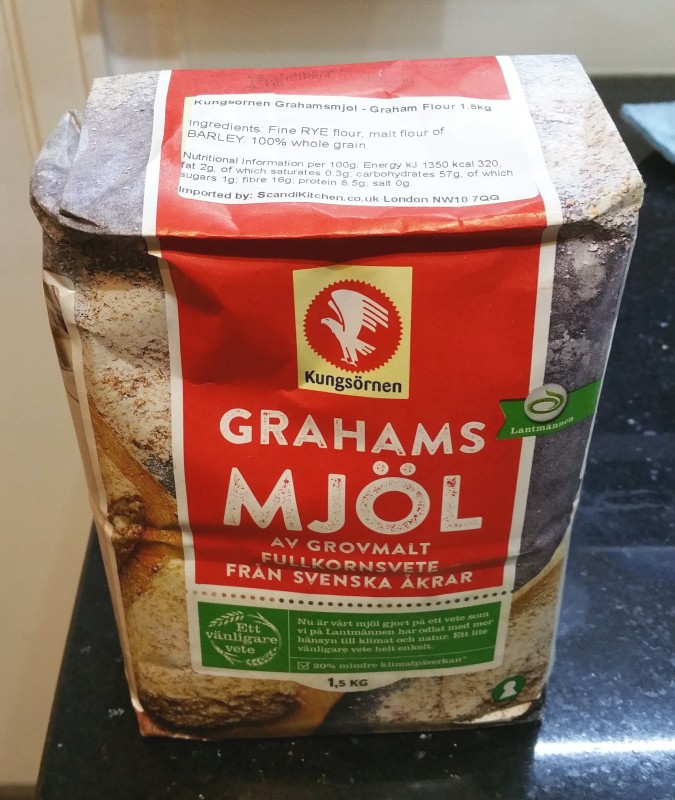December 9, 2017 - 12:28pm

Grahamsmjöl
I just bought a bag of this flour, as it looked rather interesting.
On taking a closer look, I think it's nearly 100% wholegrain rye with a bit of barley malt flour. Strangely, it reports the protein as 8.5g on the import label, but 12.0g on the original side label. I guess 8.5 sounds more likely if it's nearly all rye.
I feel a brick coming on. Any suggestions for a recipe (ideally authentic Swedish) that isn't? I'm happy to add some strong bread flour if that can lighten the crumb.
Lance



Apparently, this is a coarsely ground wheat used for crisps and crusts (as translated by google). Take a look at the Kungsornen website, keeping in mind that google translate is nowhere near perfect (apparently, avocado toast is google-translated avocado on rotten bread)
Recipes are available but will be interesting to translate. I would think any recipe for a hearty loaf would work. It is not rye but a whole, coarsley ground, winter wheat.
Thanks Clazar. Yes, it looks like the top label is duff. As you say, it's "vete" = wheat, which also explains the protein discrepancies on the two labels.
Phew! Thank goodness I don't have another 1.5kg of rye to get rid of!
Then perhaps a longer autolyse to soften it up?
Lol :)
I would suspect protein somewhere in the neighbourhood of 14%, even higher.
I go through a lot of rye when I get my hands on it. Precious! ..."getting rid of rye"... surely you jest!
Sacrilege for you, I know Mini, but I'm afraid that for some unknown reason rye and me are not a marriage made in heaven!
For those who have never or seldom eaten rye, rye can have a laxative effect. Something to do with happy gut bugs having a population party. Bacteria and fermentation releasing gas. Nothing new. Then it is better to introduce breads 5 to 20% rye before going on to the flavourful middle and higher ryes. Up to you. ;)
No, it's not that. I like rye bread, especially the ones I buy when I go to Germany and the Mischbrots, but whenever I try and make it I end up with bricks and a mushy textured and tasting crumb.
I also find that the addition of yeast to the bulk, specified in most recipes, followed by short bulk and final proof, can give an unpleasant yeasty flavour. Maybe I need to bake longer to get rid of this flavour, as I normally bake to internal temperature (95C) and crust colour.
I've even tried the full Detmolder jobbie (I have a proofing box with full temperature control) and that wasn't much better.
In short, Mini, I probably need you to provide me with a good proven Mischbrot recipe!
Lance
have you got your rye sour handy? How about a third each, rye, this wheat, and some bread flour.or go with 50% rye and split the whole wheat with bread flour. Add about a tablespoon of lemon juice for each loaf and about 75% water. Pick your fav. salt % and you're in business. Soak the whole wheat with the salt and water for a few hours and then add the mature starter and rest ingredients. A tablespoon or two olive oil for the WW and 1 to 2% bread spices.
What's the size of your narrow long deep pan? OR did you want a free form? I can narrow down the weights if you want.
Thanks Mini. A few questions:
I have been doing brotform loaves. Would a pan be better for a rye novice?
Cheers,
Lance
For one good sized loaf ...total dough weight: about 1200g or about 2.6 lbs.
I use my hands, practically a no-knead. I would give about 4 hours soak with equal weight of water + salt on the coarse wheat giving it a good stir before.... adding the rest of the ingredients letting them sit 1/2 hour to hydrate. Then do a little bit of folding or light kneading with wet hands in the bowl or on a wet surface to develop the wheat gluten for maybe a minute. Bulk for about 2 to 3 hours.
Watch the bulking dough until small gas bubbles appear in the dough (up to 1/8" or 3mm) with slight rise of about 1/3 to 1/2 more than the original volume. Fold a few times to deflate dough and shape, pinch seams firmly. (Very wet doughs can be spooned if need be into a tin.) Smoothen surface and score if desired. (A score will close up during proof to reopen during the bake.) Roll dough in seeds or flour and place in well floured banneton top down OR in a parchment lined basket (for free form top up) OR in a buttered and dusted (seeds, nut flour or flour) long narrow bread tin. The higher the hydration, the more I suggest the tin to hold up the sides of the loaf. Seed or decorate the top or dust a design on with flour and allow to rise. The final rise will be about 1/3 to 1/2 more than the original size of the dough. The variations hang with the coarseness of the rye and wheat flours used. The finer, the higher the rise. So if the dough fills a dark tin 3/4 with dough, allow dough to rise to edge of tin and hump up in the middle. If you should see any pin whole bubbles breaking the surface of the dough, it is very close to being over-proofed and should be baked immediately. The final rise will take anywhere from 2 hours to 4 hours depending on the fermenting dough. Dock the dough ever square inch (3cm) with a wet toothpick or skewer at least half way into the loaf to release any large gas pockets under the surface. After a minute, the dough can be smoothened with a wet spatula or spoon if desired.
Cover with a double foil tent giving plenty of room (or a second bread pan.) Mist the inside of the tent cover. The dough volume can easily double (from original size) under ideal conditions during the bake.
Bake 220°C (425°F) for the first half hour and lower to 200°C (400°F) 180°C (360°F) if uncovered, for the rest of the bake. Remove foil tent to brown the top of the loaf about 3/4 into the bake. Shapes vary, long skinny loaves take about 50 minutes to an hour and round loaves longer. Anywhere up to 1 1/4 hrs. Very flat loaves bake under an hour. Bake until inside temp reaches to 98°C (210°F.) If the dough catches you by surprise with a cold oven, Place in oven while preheating when oven temp is over 150°C. Letting dough rise with the temp to 220°C and then turning it down after half an hour. (you see? very flexible recipe) Should you smell burning, turn down the oven temp a bit.
Cool on rack for several hours and when cold, wrap tightly. Better the next day or later. Cut with a very sharp, not serrated knife.
one loaf:
Enjoy.
Many thanks for the in-depth instructions - just what I need. I'll let you know how I get on.
Lance
I made the Mischbrot just before Christmas. The loaves didn't turn out too beautiful - I proved and baked them in a metal double U pan I have; maybe not the best shape for this type of loaf.
But the flavour was good (very nutty) and the bread went very nicely with our smoked salmon on Christmas Day.
So I might have to try rye one more time!
Lance
Sylvester Graham . You don't see many Sylvester's now a days but what it is what I make all the time at home. Unbolted coarsely ground whole wheat where noting is missing from the whole grain. Fantastic flour it is too especially when freshly milled.
https://en.wikipedia.org/wiki/Graham_flour